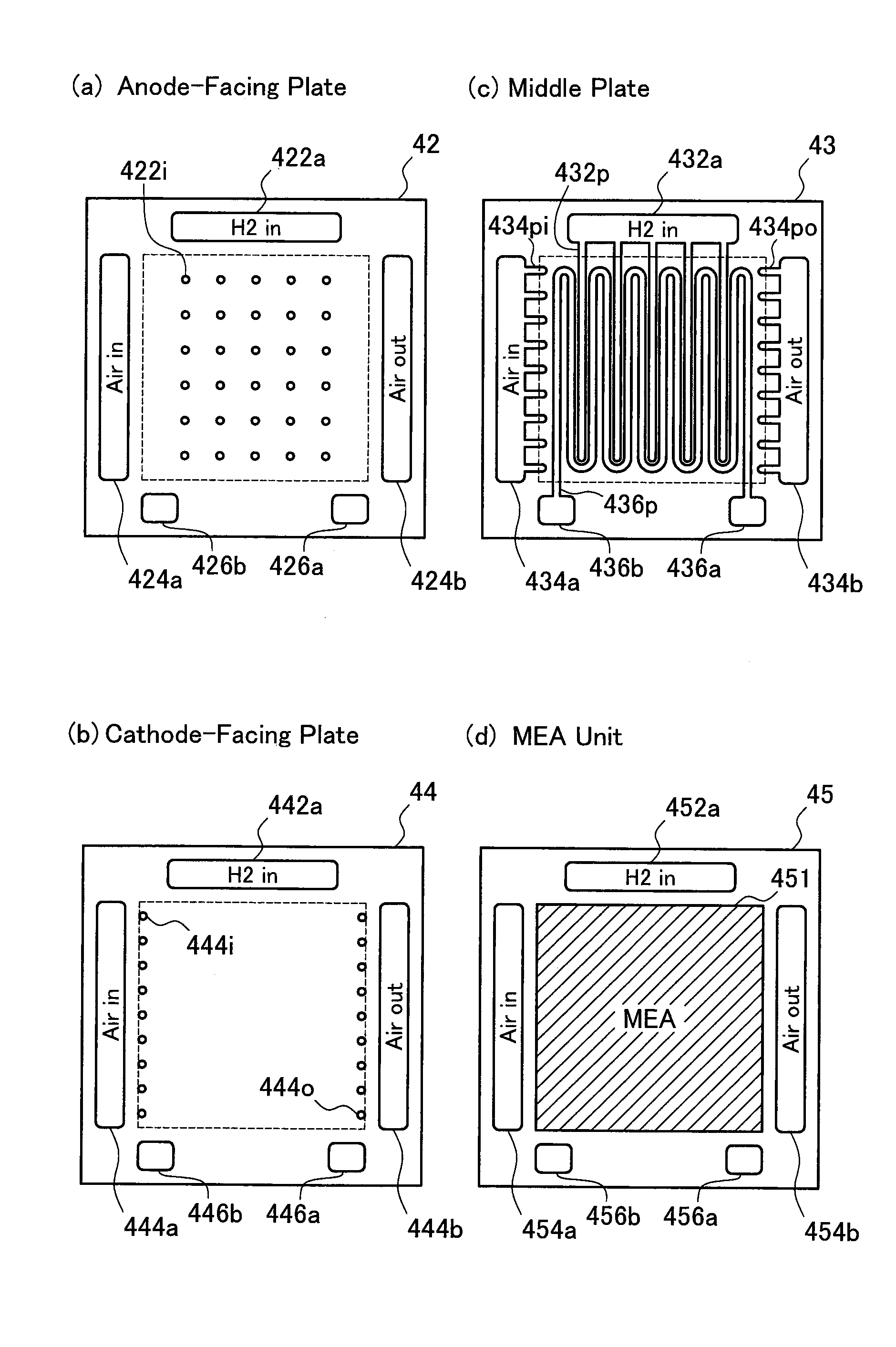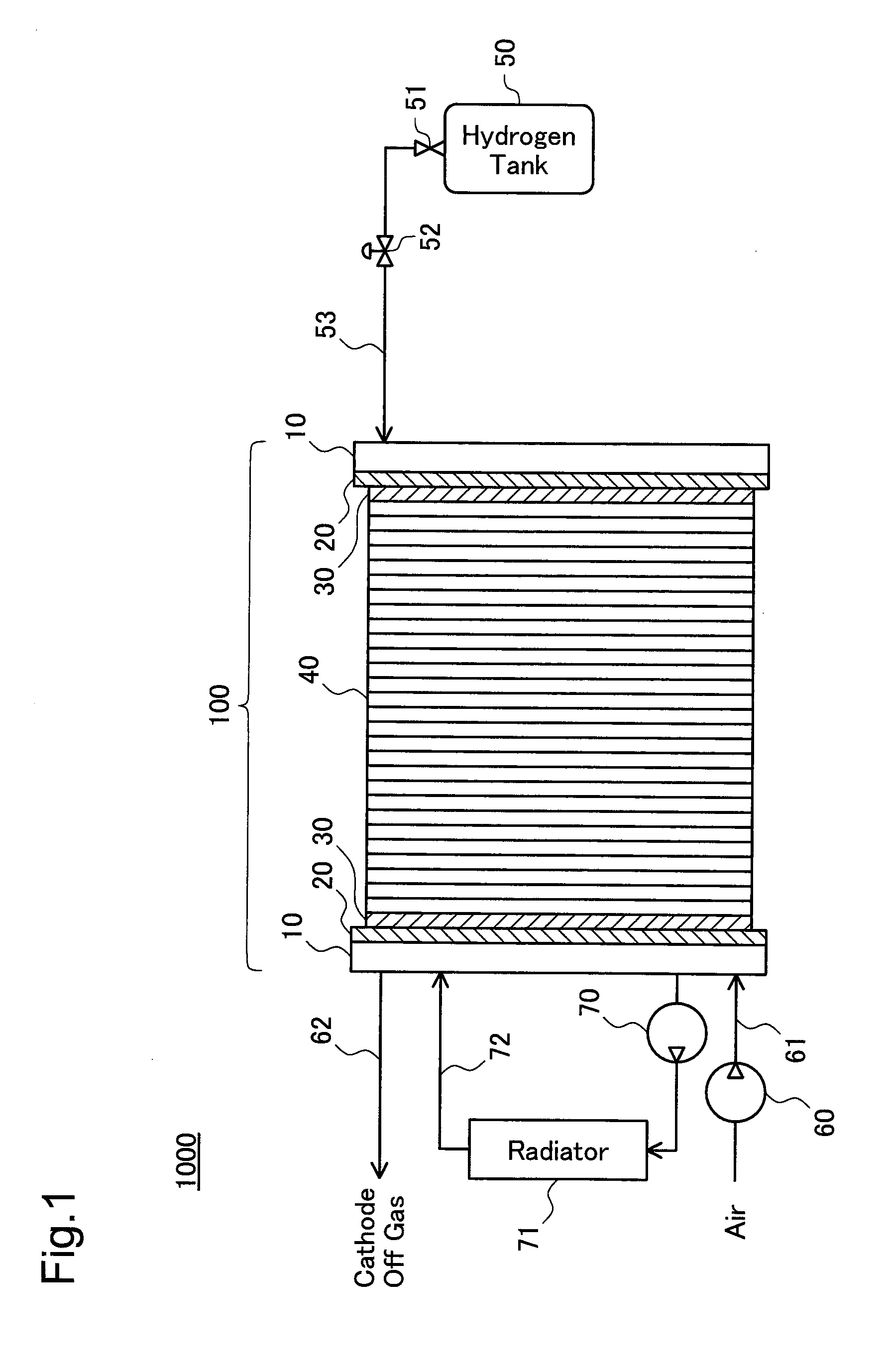Fuel cells
a fuel cell and cell technology, applied in the field of fuel cells, can solve the problems of reducing the power generation capacity of the fuel cell, reducing the power generation capacity, and the reactive gas may not be fully fed over the whole face of the catalyst electrode, and achieve the effect of convenient processing and efficient power generation
- Summary
- Abstract
- Description
- Claims
- Application Information
AI Technical Summary
Benefits of technology
Problems solved by technology
Method used
Image
Examples
first embodiment
A. First Embodiment
A1. Structure of Fuel Cell System
[0076]FIG. 1 schematically illustrates the structure of a fuel cell system 1000 including a stack of fuel cells or fuel cell stack 100 in a first embodiment of the invention.
[0077]The fuel cell stack 100 has a stack structure of multiple cell laminates stacked via separators. Each cell laminate generates electricity through electrochemical reaction of hydrogen with oxygen and has an anode and a cathode arranged across a proton-conductive electrolyte membrane as explained later. A solid polymer membrane is adopted for the electrolyte membrane in this embodiment. The separator of this embodiment consists of three flat metal plates that are stacked and joined together and respectively have multiple through holes. The three metal plates of the separator form a flow path of hydrogen as a fuel gas to be supplied to the anode, a flow path of the air as an oxidizing gas to be supplied to the cathode, and a flow path of cooling water. The n...
second embodiment
B. Second Embodiment
[0104]A fuel cell system of a second embodiment has a similar structure to that of the fuel cell system 1000 of the first embodiment, except a fuel cell stack that is different from the fuel cell stack 100 of the first embodiment. The following description thus regards the structure of the fuel cell stack in the second embodiment.
[0105]FIG. 6 is plan views showing constituents of a fuel cell module 40A in the fuel cell stack of the second embodiment. Like the fuel cell module 40 of the first embodiment, the fuel cell module 40A of the second embodiment is constructed by stacking a separator 41A and an MEA unit 45A. The separator 41A is obtained by stacking an anode-facing plate 42A, a middle plate 43A, and a cathode-facing plate 44A in this sequence and hot pressing the laminate of these three plates. In the structure of this embodiment, the anode-facing plate 42A, the middle plate 43A, and the cathode-facing plate 44A are stainless steel plates of an identical r...
third embodiment
C. Third Embodiment
[0118]FIG. 9 schematically illustrates the structure of a fuel cell system 1000B including a fuel cell stack 100B in a third embodiment. Unlike the fuel cell system 1000 of the first embodiment, the fuel cell system 1000B of the third embodiment includes an exhaust pipe 56 to discharge the anode off gas out of the fuel cell stack 100B and a circulation pipe 54 to recirculate the anode off gas to a pipe 53 for hydrogen supply. The exhaust pipe 56 is equipped with an exhaust valve 57, and the circulation pipe 54 is equipped with a pump 55. The fuel cell stack 100B also has a structure of discharging the anode off gas as explained later. Controlling the operations of the pump 55 and the exhaust valve 57 switches over the flow of the anode off gas between discharge out of the fuel cell stack 100B and recirculation to the pipe 53. The other structural elements of the fuel cell system 1000B of the third embodiment are identical with those of the fuel cell system 1000 of...
PUM
| Property | Measurement | Unit |
|---|---|---|
| thickness | aaaaa | aaaaa |
| specific area | aaaaa | aaaaa |
| area | aaaaa | aaaaa |
Abstract
Description
Claims
Application Information
 Login to view more
Login to view more - R&D Engineer
- R&D Manager
- IP Professional
- Industry Leading Data Capabilities
- Powerful AI technology
- Patent DNA Extraction
Browse by: Latest US Patents, China's latest patents, Technical Efficacy Thesaurus, Application Domain, Technology Topic.
© 2024 PatSnap. All rights reserved.Legal|Privacy policy|Modern Slavery Act Transparency Statement|Sitemap



